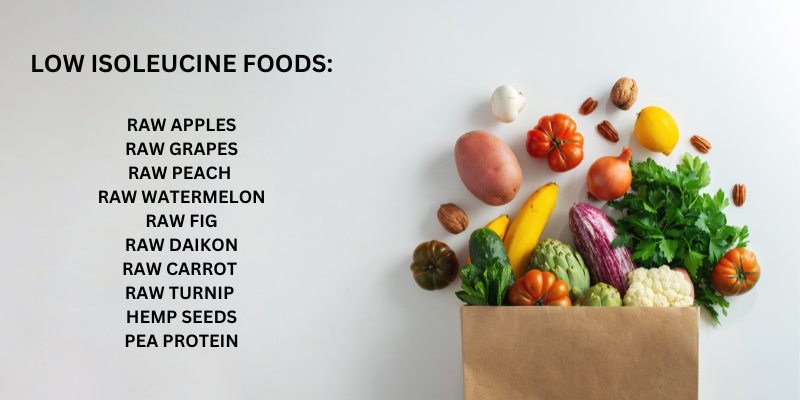What Is A Low Isoleucine Diet
Navigating the Low Isoleucine Diet: Understanding its Impact and Implementation
In the realm of specialized diets aimed at addressing various health concerns, the low isoleucine diet has gained attention for its potential therapeutic benefits. Isoleucine is one of the nine essential amino acids, crucial for protein synthesis, muscle maintenance, and overall metabolic function. However, for individuals with certain metabolic disorders or specific health conditions, limiting isoleucine intake may be necessary. In this article, we’ll delve into the intricacies of the low isoleucine diet, exploring its rationale, potential benefits, and practical considerations for implementation.
What is Isoleucine:
Isoleucine is classified as an essential amino acid, meaning it cannot be synthesized by the body and must be obtained through dietary sources. Alongside leucine and valine, isoleucine belongs to the branched-chain amino acids (BCAAs), which play pivotal roles in various physiological processes, including muscle growth, immune function, and energy production.
Dietary sources rich in isoleucine include animal proteins such as meat, poultry, fish, eggs, and dairy products, as well as plant-based sources like legumes, nuts, seeds, and whole grains. While isoleucine is necessary for overall health, certain medical conditions may necessitate its restriction to manage symptoms and optimize health outcomes.
Who Is A Low Isoleucine Diet Good For:
A low isoleucine diet may be recommended in the following scenarios:
- Maple Syrup Urine Disease (MSUD): MSUD is a rare genetic disorder characterized by the body’s inability to metabolize BCAAs, including isoleucine, leucine, and valine. Accumulation of these amino acids can lead to toxic levels in the blood, causing severe neurological symptoms and potentially life-threatening complications. Individuals with MSUD require strict dietary management, including a low-protein diet with restricted intake of BCAAs.
- Other Metabolic Disorders: Certain metabolic disorders may involve abnormalities in amino acid metabolism, necessitating dietary modifications to prevent metabolic imbalances and associated complications. A low isoleucine diet may be part of the therapeutic approach in these cases.
- Neurological Conditions: Some research suggests that reducing dietary intake of BCAAs, including isoleucine, may have potential benefits for certain neurological conditions, such as epilepsy and neurodegenerative diseases. However, further studies are needed to elucidate the precise mechanisms and clinical implications.
Benefits of a Low Isoleucine Diet:
The primary goal of a low isoleucine diet is to mitigate the risk of metabolic decompensation and prevent the accumulation of toxic metabolites in individuals with metabolic disorders like MSUD. By restricting isoleucine intake, patients can better manage their condition and reduce the likelihood of acute metabolic crises.
Furthermore, emerging evidence suggests that manipulating BCAA levels through dietary interventions may have broader implications for metabolic health and longevity. Some studies propose that reducing BCAA intake could modulate metabolic pathways associated with aging, insulin resistance, and metabolic syndrome. However, more research is needed to elucidate the long-term effects and optimal strategies for BCAA restriction in the general population.
Low Isoleucine Foods:
When following a low isoleucine diet, it’s essential to be mindful of food choices to minimize isoleucine intake. Here are some examples of low isoleucine foods:
- Fruits: Most fruits are low in isoleucine and can be included in a low isoleucine diet. Examples include apples, oranges, bananas, berries, and melons.
- Vegetables: Non-starchy vegetables like leafy greens, cucumbers, bell peppers, carrots, and zucchini are generally low in isoleucine.
- Grains: Whole grains such as rice, oats, quinoa, and barley contain relatively low levels of isoleucine compared to protein-rich grains like wheat.
- Legumes: While legumes are a source of protein, some varieties such as lentils and chickpeas have lower isoleucine content compared to other legumes like soybeans and peanuts.
- Fats and Oils: Most fats and oils are virtually free of isoleucine and can be used liberally in cooking and food preparation.
By incorporating these low isoleucine foods into meals and snacks, individuals following a low isoleucine diet can meet their nutritional needs while minimizing isoleucine intake.

Low Isoleucine Protein Sources:
Finding suitable protein sources on a low isoleucine diet requires careful selection. Here are some examples of low isoleucine protein sources:
- Gelatin: Gelatin is a protein derived from collagen and is low in isoleucine. It can be incorporated into desserts, soups, and snacks.
- Rice Protein: Rice protein powder is an alternative to traditional protein powders and is low in isoleucine. It can be used in smoothies, shakes, and baking recipes.
- Hemp Seeds: Hemp seeds are a complete protein source and contain all nine essential amino acids, including isoleucine, but in lower quantities compared to other sources like soy and dairy.
- Pea Protein: Pea protein is derived from yellow peas and is low in isoleucine. It’s available as a powder and can be added to smoothies, oatmeal, and baked goods.
- Sunflower Seeds: Sunflower seeds are a good source of protein and are low in isoleucine. They can be enjoyed as a snack or added to salads, yogurt, and granola.
How to Do A Low Isoleucine Diet:
Implementing a low isoleucine diet requires careful planning and monitoring, particularly for individuals with metabolic disorders under medical supervision. Here are some key considerations:
- Consultation with Healthcare Professionals: Before initiating a low isoleucine diet, individuals should consult with a healthcare provider, preferably a registered dietitian or metabolic specialist familiar with the specific dietary requirements of their condition. Medical supervision is crucial to ensure nutritional adequacy and prevent complications.
- Dietary Modification: A low isoleucine diet involves reducing or eliminating high-isoleucine foods from the diet while ensuring adequate intake of other essential nutrients. This may entail substituting animal proteins with low-protein alternatives and selecting foods with lower BCAA content.
- Regular Monitoring: Patients following a low isoleucine diet, particularly those with metabolic disorders, should undergo regular monitoring of nutritional status, metabolic parameters, and clinical symptoms. Adjustments to the diet may be necessary based on individual tolerance and response.
- Education and Support: Education and support are paramount for individuals and families navigating dietary restrictions. Providing resources, meal planning guidance, and ongoing support can empower patients to adhere to their dietary regimen while maintaining optimal health and quality of life.
The low isoleucine diet represents a specialized dietary approach with significant implications for individuals with metabolic disorders like MSUD and potentially broader applications in the realm of metabolic health. By understanding the rationale, benefits, and practical considerations associated with a low isoleucine diet, healthcare professionals and patients alike can collaborate to optimize dietary management and improve clinical outcomes. However, further research is needed to elucidate the long-term effects and therapeutic potential of BCAA restriction in diverse populations. In the meantime, individualized care and evidence-based guidance remain paramount in navigating the complexities of dietary interventions for metabolic health and well-being.
Published by HOLR Magazine.


